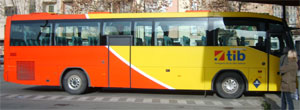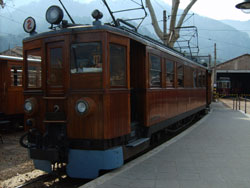Bus on Mallorca
Long-distance transport
There is a well-developed bus network on Mallorca that covers both local and long-distance transport. The buses are operated by TIB (Transports de les Illes Balears). They connect the main cities and tourist areas of the island, including Palma, Alcúdia, Sóller, Pollença and Cala Ratjada.

Long-distance transport on Mallorca:
1.Direct connections:
The long-distance buses (lines usually start with the number 3 or 4) connect Palma with other large cities and resorts on the island.
Examples:
Palma – Alcúdia (line 302)
Palma – Cala Ratjada (line 411)
Palma – Sóller (line 204)
2.Stops:
Most long-distance buses start at the central intermodal station (Estació Intermodal) in Palma. This is located directly under the Placa d’Espanya.
3.Tickets:
Tickets can be booked online via the TIB website or the TIB app.
Alternatively, they can also be bought directly from the driver. A discount is often given when paying by card.
4.Times: The buses usually run from early in the morning until the evening. Some lines also have limited night services.
5.Prices: The price depends on the distance travelled. Mallorca is divided into zones that determine the price. Costs range from around €1.50 to €12 per trip.
6.Special features: Many buses are air-conditioned and offer WiFi. In high season (summer), additional buses are used to meet demand.
7. Lines and zones:
The public transport network in Mallorca is divided into different zones, each identified by specific line numbers:
100 lines (southwest): connect Palma with places like Andratx, Peguera, Santa Ponsa, Magaluf and Palmanova.
200 lines (Tramuntana Mountains): cover the Tramuntana Mountains and connect Palma with towns like Sóller, Fornalutx, Deià, Valldemossa and Bunyola.
300 lines (north and center of the island): Lead to the north and center of the island and connect Palma with places like Pollença, Alcúdia, Can Picafort, Inca, Muro, Lluc, Campanet, Santa Maria and Alaró.
400 lines (northeast): Connect Palma with the northeast of the island, including Cala Millor, Cala Bona, Cala Ratjada, Manacor and Cala Murada.
500 lines (southeast and center of the island): Cover the southeast and center of the island and connect Palma with Llucmajor, Campos, Portocolom, Felanitx, Cala Figuera, Santanyí and Cala Pi.
Most buses on Mallorca are operated by TIB
Street map, city map: If you want to see Mallorca, you should get a good map before your vacation. You also need it to plan excursions.
Local transport: Public transport in Palma de Mallorca is good and inexpensive. Important for holidaymakers are line 1 to the airport and ferry port, as well as line 15 along the Playa de Palma (“Ballermann”) to S’Arenal. There are cheaper 10-trip tickets. 10-trip tickets are available at kiosks and tobacco shops, and single tickets from the driver. In 2017, a single ticket in Palma costs 1.50 euros, and a 10-trip ticket only 10 euros. Local transport within Palma de Mallorca is therefore much cheaper than in Germany. Trips to the airport are excluded, which cost 5 euros one way (as of early 2017). There has also been an increased bus fare to the port for some time, with a ticket costing 3 euros. Unfortunately, some buses in Palma are often very overcrowded. Unfortunately, this also includes the buses to and from Ballermann, and not infrequently even outside of the season.
As there is no other major city on Mallorca besides Palma, there are hardly any local buses. The bus line along the east coast between the tourist hotspots of Port de Pollenca, Alcudia and Can Picafort is very important for tourists. Buses run very frequently between these places during the season (less frequently in winter).
Train on Mallorca
Mallorca has a small but well-functioning train network that mainly covers the center of the island. The trains are operated by SFM (Serveis Ferroviaris de Mallorca). There are two main train routes in total and one tourist train that is particularly popular.
Train lines (SFM):
Main routes:
Palma – Inca – Sa Pobla (line T1)
Connects Palma with Inca and Sa Pobla, a town near Alcudia.
Travel time: approx. 50 minutes to Sa Pobla.
Frequency: approx. every 20-30 minutes during the day.
Palma – Inca – Manacor (line T2)
Connects Palma with Inca and Manacor, the second largest town in Mallorca.
Travel time: approx. 60 minutes to Manacor.
Frequency: approx. every 20-30 minutes during the day.
Metro in Palma:
M1: Palma – University of the Balearic Islands (UIB).
M2: Connects Palma with places in the surrounding area.
“Red Lightning” (Tren de Sóller):
A historic, tourist train that connects Palma with Sóller. This route runs through the Tramuntana Mountains and is famous for its picturesque views.
 The train from Palma to Soller
The train from Palma to Soller
Route: Palma – Bunyola – Sóller.
Travel time: Approx. 1 hour.
Cost: Around €25-35 for a return trip (tourist price).
Special features: The journey in the historic carriages and the spectacular views make the route a popular attraction.
Prices & tickets:
Tickets for the SFM trains:
Depends on the number of zones travelled through.
Example: Palma – Inca approx. €3-4, Palma – Manacor approx. €4-6.
Tickets can be bought from the machine or via app.
With a TIB card there are discounts for frequent travellers.
Tourist train (“Red Blitz”):
Tickets can be bought online or at the train station in Palma.
Train stations:
Palma Estació Intermodal: Main train station, directly under Plaça d’Espanya. All trains start here.
Important train stations: Inca, Sa Pobla, Manacor, Sóller.
Palma-East Mallorca: In contrast to the train to Soller, this train is a real public transport. During the day, the route runs at least twice an hour in both directions (even at weekends). The first train leaves Palma at around 6 a.m., the last at 10:30 p.m. in the evening. All trains travel via Inca. After that, the route splits: half of the trains continue to Manacor (the second largest city in Mallorca), the other half to Sa Pobla in the north-east. The fares are quite cheap. In Inca in particular, the train timetable is coordinated with the bus timetable. This makes changing trains quick and easy. In Palma, the train station at Placa d’Espanya is underground. All train lines, many bus lines and the metro depart from or near Placa de Espanya. It is the major transfer station in Palma, or rather for the whole of Mallorca. In Mallorca, the station is therefore simply called Estaci Intermodal.
The trains take just under 40 minutes to travel from Palma de Mallorca to Inca. Every hour a train leaves the Estacio Intermodal station in Palma de Mallorca and takes 56 minutes to Sa Pobla and 70 minutes to Manacor. Train fares on Mallorca are often a little cheaper than bus fares. A trip from Mallorca to the two terminal stations Manacor and Sa Pobla costs around 4.10 euros in 2015. A return ticket costs exactly twice as much.
Map of Mallorca
Taxis on Mallorca
There are quite a few taxis in the larger towns. These are a little cheaper than in Germany. At large taxi ranks there are price boards with fixed prices for intercity journeys. Taxi drivers are usually, but not always, honest. If you haven’t negotiated an exact price, you should always check whether the taximeter is on.
Subway on Mallorca
The metro in Palma de Mallorca is a small part of the public transport network and is also operated by SFM (Serveis Ferroviaris de Mallorca). It mainly serves as a connection between the city center of Palma and the surrounding areas, in particular the University of the Balearic Islands (UIB).
Metro lines:
1.Line M1: Palma – University of the Balearic Islands (UIB)
Start: Estació Intermodal (Plaça d’Espanya) in the center of Palma.
End station: Universitat de les Illes Balears (UIB).
Stops: 9 stations in total, including Son Costa – Son Fortesa, Son Fuster Vell and Camí dels Reis.
Travel time: Approx. 13 minutes from Palma to the UIB.
Frequency: Every 15-20 minutes (more frequent on weekdays).
2.Line M2: Palma – Marratxí
Start: Estació Intermodal (Plaça d’Espanya).
End station: Marratxí (a town northeast of Palma).
Stops: Including Es Caülls – Festival Park, Pont d’Inca and Son Fuster.
Travel time: Approx. 10-15 minutes.
Frequency: Approx. every 20-30 minutes.
Tickets & prices:
Pricing system:
The metro uses the same zone system as the buses and trains on Mallorca.
Zone 1: Within Palma, e.g. to the UIB.
Zone 2: Towards Marratxí.
Ticket prices:
Single trip: Approx. €1.50 to €3.50, depending on the zone.
Discounts: Tickets are cheaper with the TIB card or as a student (e.g. for the UIB).
Where to buy tickets?
Vending machines at the stations.
Online or via the TIB app.
Stations and facilities:
All metro stations are modern, barrier-free and equipped with ticket machines, WiFi and some small shops.
The central Estació Intermodal serves as a transfer point to buses, trains and other means of transport.
Timetables:
Line M1: Runs from approx. 6:30 a.m. to 10:30 p.m.
Line M2: Runs from approx. 6:00 a.m. to 10:00 p.m.
Tram on Mallorca
There is currently only one tram on Mallorca, which runs between Sóller and Port de Sóller. It is part of the historic transport system and complements the tourist train service “Red Blitz” (Tren de Sóller). Unfortunately, tickets are quite expensive.
The Sóller tram (Tranvía de Sóller):
Route:
Start: Sóller (train station).
End station: Port de Sóller (harbor).
The route is about 5 kilometers long and leads through a picturesque landscape, including orange groves and the Tramuntana mountains.
Travel time:
About 25-30 minutes each way.
Operating times:
Run daily from about 7:00 a.m. to 10:00 p.m., depending on the season.
Frequency: Every 30 minutes.
Cost:
7 € per single trip (as of 2023).
There are no discounts for return trips.
Special features of the tram:
Historic carriages: The tram runs with original, restored wooden carriages that have been in use since their introduction in 1913.
The journey is considered a nostalgic experience and is very popular with tourists.
The tram connects the town of Sóller with its port (Port de Sóller), a charming coastal town with beaches and a promenade.
Combination with the “Red Blitz”:
Many travelers combine the tram with the “Red Blitz” train, which connects Palma with Sóller.
The tram can be reached directly from Sóller station, which allows for a seamless onward journey.
Practical tips:
During peak season (summer) it can get crowded. It is worth getting on early.
Tickets can be bought directly from the conductor on the tram.
Bicycles on Mallorca
There are many bicycle rental companies. Prices vary quite a bit, some are cheap. There are lots of bicycle tourists, especially in spring. In recent years, the government of Mallorca has made great efforts to build bicycle paths all over the island. The island is quite mountainous, and cycling is particularly strenuous in the interior of the island.
Car rental companies on Mallorca
Especially in the season, it is often safer and cheaper to book a rental car in Germany. Otherwise, there are car rental companies galore on Mallorca. In winter, prices can fall to €25 per day or even lower. In summer, prices can be high. Demand determines the price.
